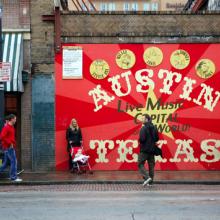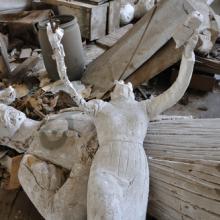mythology
 In the midst of my family’s Easter celebration yesterday, I decided to check Facebook. Most of my friends posted comments like “Happy Easter!” and shared pictures of their celebrations.
In the midst of my family’s Easter celebration yesterday, I decided to check Facebook. Most of my friends posted comments like “Happy Easter!” and shared pictures of their celebrations.
But this meme also appeared on my feed:
The meme is attributed to Richard Dawkins’ Foundation for Reason and Science and is meant to debunk Christianity and Easter as just another example of an ancient myth. The reasoning goes like this – Christianity has so much in common with other ancient myths, so how can we take Christianity seriously?
The meme shows the ancient Assyrian and Babylonian goddess Ishtar and makes a few claims against Christianity. The first is that “Ishtar” was pronounced “Easter.” The second is that Ishtar was the goddess of fertility and sex and so her symbols were an egg and bunny. The meme concludes that Easter is merely a copy of the Ishtar myth and its roots are “all about celebrating fertility and sex.”
Megan McArdle of the Daily Beast did an excellent job debunking the meme.
I WAS ONCE told that “racism is our nation’s original sin.” This statement jolted me. While I didn’t dispute its truth, I have come to realize racism is much more complex than this.
In order to dismantle the structural sin of racism, we have to first set it within a larger context that acknowledges racism’s sociopolitical dependency and structural interconnectedness.
First: “race” is not real. It is not a scientific category; biologically, it does not exist. Race is a social construct, something built systematically. It has no inherent value or true significance beyond what we give it. In order for race to have real social consequences—which it undoubtedly does—there must be other phenomena at work that validate, sustain, and reinforce the social significance of race.
As a result of sin in our fallen world, human bodies are appraised and given a value based upon certain criteria. As a result of sin, men are privileged over women, white skin is privileged over darker skin, able bodies are privileged over disabled bodies. Historically, certain bodies are acclaimed while others are defamed. Race plays a starring role in this larger drama of embodiment.
AUSTIN, Texas — After a walk around the Texas Statehouse, it became clear they tell a different history here.
Inside the Capitol is a large painting of a onetime Tennessee congressman named David Crockett, who failed in a re-election bid and stormed out west to join the revolution in what was then called Tejas. He arrived in 1836 and died four weeks later at the Alamo in San Antonio.
A plaque beneath the oversized painting suggests Crockett was a laborer who became larger than life when he got to Texas. A more balanced account suggests Crockett had been building his legend for many years, with exotic garb, a self-published autobiography, and fiery speeches against President Andrew Jackson. He yearned to star in Washington, and when that failed, he went west, landing at the Alamo just in time to die there.
An ambitious state needs its mythology.
Good and gracious God,
Today, like the rest of the world,
when I woke I wrapped myself in myths.
They are comfortable and warming in what can seem like such a cold world.
Yes, they are old and worn but they are familiar
and even the most fashion forward find comfort in this thread-worn garb.
They tell me that while it may not be fair
that 1,600 children die from hunger everyday,
I can do nothing about it.
They silence my own judgment of myself
when I put a quarter in the cup of a homeless man
as I walk on by the lack in his life
to live into the abundance of mine....

